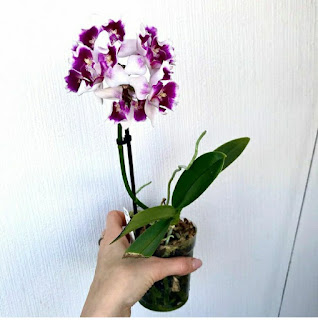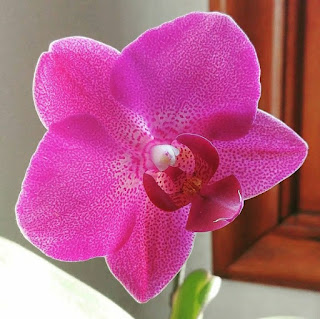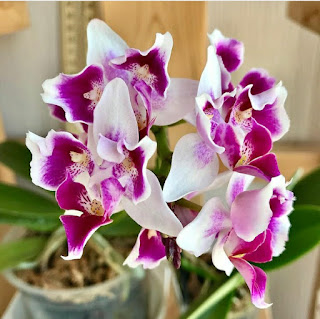Doritenopsis is a type of orchid, the care of which at home among orchids is the least difficult. For this reason, beginners who want to start breeding these flowers for the first time are traditionally recommended to start with it. Or with a hybrid phalaenopsis, which bears great resemblance to her. Those who received an orchid as a gift and are at a loss how to care for it are most likely also dealing with one of these two varieties, since they are most often sold in flower shops and on the shelves of large supermarkets.
general description
Like all representatives of Orchids (Orchids), dorithenopsis has complex and beautiful inflorescences. It is the result of crossing two garden forms: the pleasant phalaenopsis with the most beautiful doritis. It belongs to the monopodial type, characterized by a strict upward growth of the shoot (without the formation of a bush) throughout its life. In the root rosette, 8-10 oval leaf plates with a length of about 10 cm of saturated green color can form. The stem is short, usually hidden under the leaves. Upright peduncles are abundantly covered with elongated buds, colored, with few exceptions, in a mauve palette.
Flowering stems can grow up to half a meter in height, but they are 2 times shorter. The doritenopsis orchid blooms 1-2 times a year, but for a long time, often for 4-5 months, i.e. almost continuously, but not a short period of rest. The flower stalks with buds stand well in the cut.
Content of table
1.And the orchid is white!
2.Not everything is so sad
3.Doritenopsis and phalaenopsis - differences
4.Soil requirements
5.Planting capacity
6.Lighting
7.Temperature
8.Watering
9.Air humidity
10. Top dressing
11.Transfer
12.Reproduction of doritenopsis
By dividing the bush
13.Planting daughter formations
14.Seed method
15.Peduncle propagation
And the orchid is white!
An inexperienced customer often cannot pass by such a miracle as a blue-blue orchid (blue mini and others) in a store. Indeed, bewitchingly beautiful! However, we hasten to disappoint, these are painted flowers. More honest sellers indicate this on the label, but there are those who, foaming at the mouth, prove that this is the rarest natural phenomenon and put an appropriate price tag on it. The result is always the same - the next bloom will be regular white. But this is not so bad. If blue flowers are produced using a patented immersion technology (which, of course, is kept secret), then the loss of pigment over time is the worst of evils. But, not owning a technique that is harmless to the plant, manufacturers and sellers often go the simpler and cheaper way, barbarously injecting blue pigment into the stems, roots or peduncles with a syringe. If the injection was made in the peduncle, the plant will hurt, but it may survive. An injection into the roots and stem leads to the fact that it simply suffocates and dies.
When buying blue orchids, you should carefully examine all parts of the plant. With the right technology, the blue color should only be present in the buds!
Not everything is so sad
Despite the fact that natural blue doritis and doritenopsis do not exist (they simply do not have a pigment that gives a bright blue color), there are a number of rare varieties with a natural pale blue, gray-blue and light lilac palette - doritenopsis purple martin blue, violacea and pulcherrima coerulea, purple queen, and a few others. These are mainly primary hybrids based on specific orchids, but with smaller flowers.
Doritenopsis and phalaenopsis - differences
Despite the great similarity and eternal confusion of these two orchids, there are noticeable differences in their appearance. Doritenopsis has a smaller size, but a larger number of leaves, forming pairs one above the other. It blooms more profusely with an upright flower panicle, but its flowers are smaller in comparison with phalaenopsis. Both types have the same requirements for agricultural technology. There is no difference in this regard between their miniature culvars and varieties of standard size.
Soil requirements
The moment is very important, since many people buy ready-made "Soil for Orchids", which is not suitable for doritenopsis. 3 conditions must be met:
The substrate should not contain garden soil.
Its texture must be such that it is able to hold the plant upright.
The water throughput should be as high as possible to exclude moisture retention.
Do not be afraid to compose the soil yourself. To the observance of the above conditions, it should be added that the plant belongs to epiphytes that live on trees and other textures, but do not feed on them. They have aerial roots for fastening, and they know how to get everything they need from the air and precipitation. The following components should be included in the substrate:
bark (usually pine);
fragments of pine cones;
roots (best of all fern);
expanded clay and / or charcoal;
polystyrene;
vermiculite or other layered minerals;
sphagnum;
perlite or similar rocks;
leaf humus;
coconut fiber;
peat.
The presence of all these components is not at all necessary; you can even limit yourself to one pine bark.
Place a granite stone on the bottom of the orchid pot for stability and water drainage. Pre-drip vinegar on it - there should be no hiss!
Like all orchids, doritenopsis requires transparent dishes for root photosynthesis. Large drainage holes are required for quick and complete drainage of water. The size of the pot should not be large so that the roots can freely reach the transparent walls. In natural conditions, they are completely open. For the same purpose, the plant should not be deeply buried in the substrate.
Lighting
The pot with the plant should be placed in a moderately lit place, excluding direct exposure to midday sunlight. The eastern window would be ideal from this point of view. Despite the low light requirements, the orchid will not grow normally in the depths of the room.
Temperature
The optimum temperature is +20 ° C, regardless of the season. In general, the plant lives well in a fairly wide temperature range from + 10C to + 30C. It is able to withstand even short-term drops to + 5C, but under the only condition - the substrate at this time must be completely dry. Prolonged heat above + 30C, like all relatives, also does not tolerate well. If such conditions become unavoidable, it is necessary to reduce watering and ensure good ventilation of the room.
Watering
The golden rule is that it is better to underfill than overflow. Doritenopsis easily tolerates drought, but loves uniform, moderate moisture. The signal that the time has come to water the plant is the absence of condensation on the inner walls of the dishes, the light color of the roots and bark in the pot. If you raise the flowerpot, you can feel that it has become quite light. It is difficult to name the watering interval, since there are many components that affect this: characteristics of the substrate, weather, temperature, season, humidity, etc. But the average can be called the frequency of 1 every 2 weeks. It is better to do this with a bang, so that by nightfall the roots have time to dry out as much as possible.
Watering can be done in two ways.
Immerse the pot in water at room temperature 1/3 of the height for about 20-30 minutes, after which the liquid is carefully drained.
Installation under a light, barely warm shower under running water with simultaneous drainage through the drainage holes (simulated tropical rain). The water pressure must be very low. Time is 15-20 minutes.
If there are several orchids, each should be submerged in individually clean water to avoid possible transmission of infection or pests.
Air humidity
Sometimes you can find recommendations for daily spraying of this plant. This is hardly necessary, as is the placement of pallets with wet expanded clay. From time to time, you can spray air from a spray bottle - that will be enough. In this case, it is necessary to ensure that the drops of water flowing down the leaves do not collect in a puddle in the center of the outlet, this can lead to rapid decay of the neck. The same goes for watering.
Top dressing
It is enough to feed the plant once every 3 weeks, but only in the active phases of development (flowering, ejection of a peduncle or leaves). Special formulations are suitable for both orchids and any indoor plants. But in this case, it is necessary to reduce by half or even three times the concentration recommended on the package. Top dressing is done through watering.
You can not fertilize a sick doritenopsis, as well as a plant in a state of relative dormancy, i.e. when it does not bloom and does not give new roots and leaves.
Transfer
A planned transplant is carried out every 2 years, but circumstances often arise that require urgent action, in particular:
decomposed substrate (bark) that has turned into rotten dust;
pest detection;
rotting roots from excess moisture;
the roots are cramped, they have outgrown the dishes;
the plant has lost its stability, dangles in a pot.
The old soil becomes moisture-consuming over time, which is detrimental to the root system. In addition, with increased hardness of tap water, it becomes saline. However, more frequent transplants are not recommended for no particular reason. it is always stress that slows down the development of leaves and roots and flowering.
Monopodial orchids are usually transplanted in the spring, when new root growth begins, as evidenced by their green tips. The least favorable time is from mid-autumn to February.
Before transplanting, the plant must be well dried.
If the plant is difficult to get out of the pot without moisture, it can be moistened, but then left open to dry for at least 8 hours. It is sometimes difficult to extract the plant even after that. The soft plastic pot can be squeezed from all sides to make the procedure easier.
The next step is to remove the substrate. If this requires separating the roots, then this is done from the bottom up. What has grown into the bark does not need to be touched. Everything is carefully examined for pests, pathologies and dead roots. You can determine their viability with a light press. If at the same time mucus is released from the root, the site must be removed. Healthy roots, even if they are broken off or their shape does not "fit" into the overall picture, cannot be removed! Can be treated with a fungicide.
Now we equip the drainage layer and gradually fill up the substrate, trying to place it between the roots, tapping the container on the table and turning it slightly. Large pieces of bark are placed below, small pieces - above. After the end of the transplant, the plant should under no circumstances wobble in the dishes!
The first watering is allowed no earlier than a week later, in order to allow the damaged roots to regenerate. Direct sunlight should also be excluded for this time.
Reproduction of doritenopsis
It is produced in several ways.
By dividing the bush
It is better to combine division with a transplant. To do this, a dried specimen taken out of the pot is cut in half with a sharp sterile (treated with alcohol) instrument until the roots begin to branch. After that, they are simply neatly unraveled. It is impractical to divide into more parts. Both delenki must have a full-fledged root system. Until the transplanted parts show "signs of life", they are kept in partial shade.
Planting daughter formations
After flowering, dorithenopsis usually develop daughter rosettes to the side of the main one. You can separate them for reproduction when their own root system is sufficiently developed. After that, it remains to carefully separate it from the parent bush and plant it in a small container, but in compliance with the usual rules for this plant.
Seed method
The material can be obtained after flowering, which usually takes 2-3 years. The process is not recommended due to its length and unpredictability of the result.
Peduncle propagation
After the end of flowering, the flower-bearing stem is cut off at the base and cut into 3-4 cm segments.It is important that each division has a dormant bud in the central part. The rest of the process is identical to conventional cuttings in other houseplants. Germination temperature is + 25 ... + 28C.
The peduncle can be placed in the stimulant solution as a whole. After waiting for the sleeping kidneys to give rise to children, they are deposited in separate containers.







.jpeg)


0 Comments
Post a Comment